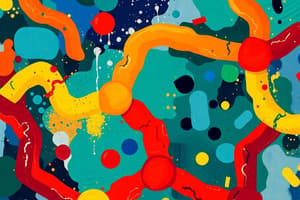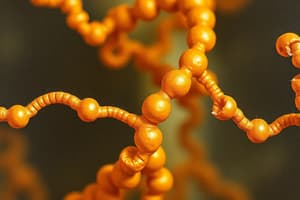Podcast
Questions and Answers
What kind of bonds hold amino acids together?
What kind of bonds hold amino acids together?
Covalent bonds
What are peptide bonds?
What are peptide bonds?
Covalent bonds formed between the carboxyl group of one amino acid and the amino group of another
What are polypeptides?
What are polypeptides?
Proteins
Each type of protein has its own unique amino acid sequence.
Each type of protein has its own unique amino acid sequence.
What is the amino group made of?
What is the amino group made of?
What's the carboxyl group made of?
What's the carboxyl group made of?
How are peptide bonds formed?
How are peptide bonds formed?
Peptide bond formation is not a condensation reaction.
Peptide bond formation is not a condensation reaction.
What is the polypeptide backbone?
What is the polypeptide backbone?
Each end of the polypeptide chain is the same.
Each end of the polypeptide chain is the same.
What is the N-terminus?
What is the N-terminus?
What is the C-terminus?
What is the C-terminus?
What are side chains?
What are side chains?
Side chains aren't involved in peptide bonding.
Side chains aren't involved in peptide bonding.
The C-terminus gives proteins their unique properties.
The C-terminus gives proteins their unique properties.
What is aspartic acid abbreviated as?
What is aspartic acid abbreviated as?
What is glutamic acid abbreviated as?
What is glutamic acid abbreviated as?
What is arginine abbreviated as?
What is arginine abbreviated as?
What is lysine abbreviated as?
What is lysine abbreviated as?
What is histidine abbreviated as?
What is histidine abbreviated as?
What is asparagine abbreviated as?
What is asparagine abbreviated as?
What is glutamine abbreviated as?
What is glutamine abbreviated as?
What is serine abbreviated as?
What is serine abbreviated as?
What is threonine abbreviated as?
What is threonine abbreviated as?
What is tyrosine abbreviated as?
What is tyrosine abbreviated as?
What is alanine abbreviated as?
What is alanine abbreviated as?
What is glycine abbreviated as?
What is glycine abbreviated as?
What is valine abbreviated as?
What is valine abbreviated as?
What is leucine abbreviated as?
What is leucine abbreviated as?
What is isoleucine abbreviated as?
What is isoleucine abbreviated as?
What is proline abbreviated as?
What is proline abbreviated as?
What is phenylalanine abbreviated as?
What is phenylalanine abbreviated as?
What is methionine abbreviated as?
What is methionine abbreviated as?
What is tryptophan abbreviated as?
What is tryptophan abbreviated as?
What is cysteine abbreviated as?
What is cysteine abbreviated as?
Polar amino acids are hydrophilic.
Polar amino acids are hydrophilic.
Nonpolar amino acids are hydrophobic.
Nonpolar amino acids are hydrophobic.
What allows proteins to be flexible and fold in numerous ways?
What allows proteins to be flexible and fold in numerous ways?
What are the restrictions of the shape of proteins?
What are the restrictions of the shape of proteins?
Covalent bonds help proteins fold up and hold their shape.
Covalent bonds help proteins fold up and hold their shape.
What are the types of noncovalent bonds that exist in proteins?
What are the types of noncovalent bonds that exist in proteins?
More noncovalent bonds result in a more stable protein structure.
More noncovalent bonds result in a more stable protein structure.
What happens to hydrophobic molecules in the aqueous environment of the cell?
What happens to hydrophobic molecules in the aqueous environment of the cell?
How do proteins fold in terms of the polar and nonpolar amino acids?
How do proteins fold in terms of the polar and nonpolar amino acids?
What are polar amino acids bonded to within a protein?
What are polar amino acids bonded to within a protein?
What is conformation in proteins?
What is conformation in proteins?
What energetic considerations determine the folded structure of proteins?
What energetic considerations determine the folded structure of proteins?
What does it mean when a protein is denatured?
What does it mean when a protein is denatured?
What happens when a protein is denatured?
What happens when a protein is denatured?
All information necessary to fold a protein is in its amino acid sequence.
All information necessary to fold a protein is in its amino acid sequence.
All proteins have one conformation that is unchanging.
All proteins have one conformation that is unchanging.
What are prions?
What are prions?
Misfolded proteins cause numerous neurodegenerative diseases.
Misfolded proteins cause numerous neurodegenerative diseases.
Prions cannot convert normal proteins.
Prions cannot convert normal proteins.
What are chaperone proteins?
What are chaperone proteins?
What is the backbone model of proteins?
What is the backbone model of proteins?
What is the ribbon model of proteins?
What is the ribbon model of proteins?
What is the wire model of proteins?
What is the wire model of proteins?
What is the space-filling model of proteins?
What is the space-filling model of proteins?
What is the alpha helix?
What is the alpha helix?
What are beta sheets?
What are beta sheets?
Why are alpha helices and beta sheets common patterns?
Why are alpha helices and beta sheets common patterns?
What are properties of alpha helices?
What are properties of alpha helices?
How do alpha helix shaped proteins pass through membranes?
How do alpha helix shaped proteins pass through membranes?
What is a coiled-coil?
What is a coiled-coil?
Most coiled-coils have the hydrophilic amino acids on the inside.
Most coiled-coils have the hydrophilic amino acids on the inside.
What are the properties of beta sheets?
What are the properties of beta sheets?
What are amyloid fibers?
What are amyloid fibers?
What is the primary structure of proteins?
What is the primary structure of proteins?
What is the secondary structure of proteins?
What is the secondary structure of proteins?
What is the tertiary structure of proteins?
What is the tertiary structure of proteins?
What is the quaternary structure of proteins?
What is the quaternary structure of proteins?
What is a protein domain?
What is a protein domain?
What are the properties of protein domains?
What are the properties of protein domains?
What is an intrinsically disordered sequence?
What is an intrinsically disordered sequence?
What are the properties of intrinsically disordered sequences?
What are the properties of intrinsically disordered sequences?
Few of the many possible polypeptide chain combinations are useful.
Few of the many possible polypeptide chain combinations are useful.
Slight changes don't affect most proteins.
Slight changes don't affect most proteins.
What are protein families?
What are protein families?
Noncovalent bonds hold proteins together.
Noncovalent bonds hold proteins together.
What are binding sites?
What are binding sites?
What is a subunit in proteins?
What is a subunit in proteins?
What is a dimer?
What is a dimer?
What are globular proteins?
What are globular proteins?
What are fibrous proteins?
What are fibrous proteins?
What are the properties of fibrous proteins?
What are the properties of fibrous proteins?
What are polypeptide chains often stabilized with to withstand being outside the cell?
What are polypeptide chains often stabilized with to withstand being outside the cell?
What is a disulfide bond?
What is a disulfide bond?
Disulfide bonds change the conformation of a protein.
Disulfide bonds change the conformation of a protein.
Proteins bind to only one or a few select things.
Proteins bind to only one or a few select things.
What is a ligand?
What is a ligand?
What allows a protein to bind with a ligand?
What allows a protein to bind with a ligand?
Molecules with poorly matching surfaces can persist for a long time.
Molecules with poorly matching surfaces can persist for a long time.
Flashcards are hidden until you start studying
Study Notes
Amino Acids and Peptide Bonds
- Amino acids are joined by covalent bonds known as peptide bonds.
- Peptide bonds form between the carboxyl group of one amino acid and the amino group of another.
- A polypeptide is a chain of amino acids that folds into a protein.
Protein Structure
- Each protein has a unique amino acid sequence, critical to its function.
- Amino groups consist of NH3, while carboxyl groups are composed of CO2.
- The polypeptide backbone follows a repeating N-C-C pattern.
Polypeptide Chain Ends
- Polypeptide chains have distinct ends:
- N-terminus (NH3) indicates the start
- C-terminus has a free carboxyl group.
- The ends of the peptide chain differ, influencing protein behavior.
Side Chains
- Side chains extend from the backbone and are not involved in peptide bonding.
- The unique properties of proteins arise from their side chains, not the C-terminus.
Amino Acids
- Key amino acids and their abbreviations:
- Aspartic acid (Asp, D)
- Glutamic acid (Glu, E)
- Arginine (Arg, R)
- Lysine (Lys, K)
- Histidine (His, H)
- Asparagine (Asn, N)
- Glutamine (Gln, Q)
- Serine (Ser, S)
- Threonine (Thr, T)
- Tyrosine (Tyr, Y)
- Alanine (Ala, A)
- Glycine (Gly, G)
- Valine (Val, V)
- Leucine (Leu, L)
- Isoleucine (Ile, I)
- Proline (Pro, P)
- Phenylalanine (Phe, F)
- Methionine (Met, M)
- Tryptophan (Trp, W)
- Cysteine (Cys, C)
Properties of Amino Acids
- Polar amino acids are hydrophilic, and nonpolar amino acids are hydrophobic.
- Peptide bonds allow for flexibility in protein structure, enabling various folding patterns.
Protein Folding and Stability
- Proteins fold to minimize free energy and increase the universe's disorder.
- Noncovalent bonds (hydrogen bonds, ionic interactions, and van der Waals forces) are crucial for maintaining protein structure.
- More noncovalent bonds result in greater stability.
Protein Structures
- Primary structure: amino acid sequence.
- Secondary structure: local folding patterns, including alpha helices and beta sheets.
- Tertiary structure: overall 3D conformation of a single polypeptide.
- Quaternary structure: assembly of multiple polypeptide chains.
Functional Aspects of Proteins
- Protein domains can fold independently and often have distinct functions.
- Intrinsically disordered sequences enhance flexibility and interaction potential with other proteins.
- Proteins evolve, and slight changes can significantly impact functionality.
Protein Types
- Globular proteins: compact, ball-like structures.
- Fibrous proteins: elongated and rod-like, contributing to structural functions in tissues.
Stabilization and Bonds
- Fibrous proteins often have covalent cross-links to maintain stability outside cells.
- Disulfide bonds reinforce protein conformation without changing it.
Protein Interactions
- Proteins typically bind to specific molecules (ligands) using many simultaneous noncovalent bonds.
- High specificity in binding ensures proteins interact with one or few selected targets.
Studying That Suits You
Use AI to generate personalized quizzes and flashcards to suit your learning preferences.




